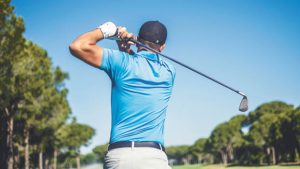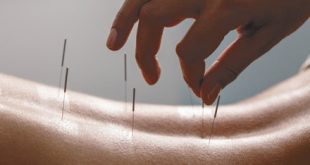By Larry Piretra, PT, DPT, CSCS, TPI-M1


Some believe that back pain is just a side effect of their golf habit. It is the most often reported injury among golfers. In fact, as many as 25% of golfers over the age of 65 report lower back pain. However, it is important to know that it can be avoided with proper technique and training.
Incorrect swing techniques and bad habits that create risk for golfers include:
• Bending too far to the trailing side during the forward swing, placing excessive force on the trailing side
• Prolonging the swing by rotating the body beyond its range of motion, increasing the risk of injury
• Engaging muscles inadequately or engaging the wrong muscles, making the muscles prone to tearing
• Rotating the leg inward at the hip with a narrow range of motion, risking injury to the hip
• Having weak core muscles, increasing the risk of muscle strain
• Playing golf for extended periods of time, leading to muscle fatigue1
Prevention of lower back pain from golfing
Strong core
Core strength is important. Core muscles are used during the golf swing. This creates potential for fatigue and injury. When fatigue or injury occurs, the muscles that compensate for injured core muscles then become at risk for fatigue and injury.
A golf screening conducted by a trained professional can identify the faults in the swing and target the corresponding muscles so that fatigue and injury do not occur. If they have already occurred, then those muscles can be targeted for rehabilitation.
One of the top swing faults associated with lower back pain is a failed overhead squat. This correlated with early extension nearly 100% of the time. A golfer with a failed overhead squat has a decreased external rotation in the right shoulder, further exacerbating the problem.
Some simple things that are also important for preventing back pain from golf are ensuring that you have the proper golf club fit, utilizing a long putter, and pushing your cart instead of pulling it around the course. These small adjustments to your game can decrease the stress and strain that you place on the lumbar spine. Also, carrying a golf bag with only one strap can be hazardous to not only the lower back, but also to the shoulder and ankle; try using a backpack style bag for your clubs instead.
Another important factor to consider in prevention of lower back pain is bodyweight. Being overweight adds a significant risk. Weight loss and diet counseling must be an integral part of prevention and/or rehabilitation when considering a golfer’s back.
Rehabilitation after an injury
The rehabilitation process after a golf injury can take place early or late. Starting to correct the problem when it first begins is obviously the best course of action.
Early rehabilitation for golfers with lower back pain must be a team effort. It should include a multidisciplinary team of professionals who work together to get the golfer back on the course safely. The team should consist of a physiatrist, a physical therapist, TPI certified professional, and a PGA teaching professional.
As mentioned above, core strength is important for preventing lower back pain. Once an injury has occurred, core stability training should be an integral part of the golfer’s rehabilitation program. A golfer without lower back pain can have as much as twice the trunk flexion velocity during the downswing. This is achieved by using those core muscles in the abdomen.
Another essential piece of the rehabilitation puzzle is transversus abdominis and multifidus training. Core stability involves more than just one set of muscles. It is a fluid, continuous motion involving many parts. Hip abductors, erector spinae, and quadratus lumborum all play a role.
Late rehabilitation focuses on the swing faults and physical imbalances of the individual golfer. Scapular and hip stabilization is part of core strength and must be achieved to prevent injury. The gluteus medius muscles stabilize the pelvis and provide a base trunk rotation. During the swing, gluteus medius inhibition increases lateral hip movement and can cause increased lateral bending at impact.
Golf Movement Screen
The sooner a golfer is able to identify his/her imbalances and swing faults, the sooner they can be corrected. This is key in preventing injuries and in complete rehabilitation. At Performance Optimal Health, we ensure personalized programming and a team approach to care, you can optimize your golf performance by improving your strength and mobility. Our Titleist Performance Institute Certified golf experts examine inefficiencies in your biomechanics and identify areas for improvement through a musculoskeletal lens.
Our professionals promote a collaborative team approach between the player, their golf pro or teaching professional, their physical therapist, and others involved in the optimization of the golfer’s performance to provide the best outcomes possible. We also have nutritionists and mental performance consultants on staff to comprehensively round out a player’s needs.
At Performance Optimal Health, we use comprehensive research and the latest technology to incorporate the four pillars of optimal health (exercise, recovery, nutrition, stress management) into your care. Each pillar plays a significant role in your optimal health journey, and using tools and services from each of the pillars can greatly enhance and expedite your path to success.
Performance Optimal Health
2260 Logan Blvd., N, Suite 302, Naples, FL 34119
6425 Naples Blvd., Naples, FL 34109
239.342.1422
PerformanceOptimalHealth.com
1. Scott Curtis, D., Golf and low back pain, Spine. Available at:
https://www.spine-health.com/conditions/sports-and-spine-injuries/
golf-and-low-back-pain .
 Southwest Florida's Health and Wellness Magazine Health and Wellness Articles
Southwest Florida's Health and Wellness Magazine Health and Wellness Articles

